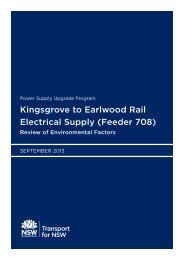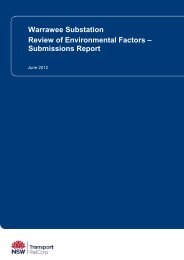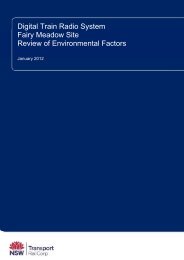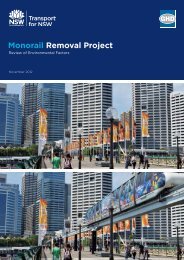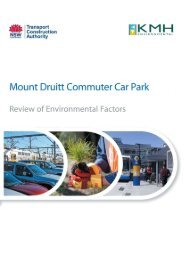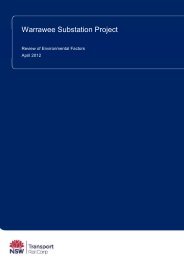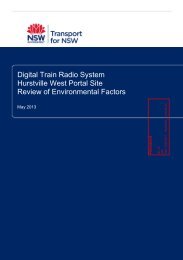Review of Environmental Factors<strong>Glenbrook</strong> commuter car park and interchange upgrade• Soil sampling of material from the surface to 0.5m, or at any changes in soil stratigraphyand within any areas of apparent contamination• Twenty‐five soil samples underwent laboratory analysis.Soil Assessment CriteriaThe criteria specified in the following publications were used <strong>for</strong> the site assessment:• Guidelines <strong>for</strong> Assessing Service Station Sites, <strong>NSW</strong> EPA 1994• National Environmental Protection Measure, 1999 (NEPM)• Waste Classification Guidelines Part 1: Classifying Waste (DECCW, 2008)In consultation with WorkCover <strong>NSW</strong> and through the Enhealth (2005) Guidelines <strong>for</strong> Asbestos in theNon‐Occupational Environment document, ADE adopted a conservative criterion <strong>for</strong> asbestos in soil being‘no detectable asbestos’ present in soils and/or no visible asbestos debris on site.6.7.3 Soil assessmentA summary of the analysis of soil samples and soil assessment criteria is provided in Appendix D.The site meets the NEPM Schedule B(1) HIL (F) guideline with regards to heavy metals (arsenic, cadmium,chromium, copper, lead, nickel, zinc), TPHs, BTEX, PAHs, OCPs/OPPs, PCBs, Total Phenolics and Cyanide.One piece of asbestos cement was detected in the DSI site inspection and collected during samplingoperations. No further asbestos was identified during the site inspection. None of the ten soil samplescollected during the hand digging operations contained asbestos.All remaining samples from throughout the site passed the OEH adopted criteria assigned <strong>for</strong> GeneralSolid Waste <strong>for</strong> heavy metals (arsenic, cadmium, chromium, lead, mercury and nickel), TPHs, BTEX, PAHs,OCPs/OPPs, PCBs, Total Phenolics and Cyanides.During the sampling procedures it was evident that the soil materials did not vary in character within thesite. Preliminary waste classification <strong>for</strong> materials <strong>for</strong> the majority of the site meets the wasteclassification of General Solid Waste (non‐putrescible). Preliminary waste classification <strong>for</strong> materialswhere the asbestos fibre was found meets the waste classification of General Solid Waste(non‐putrescible) mixed with special waste bonded asbestos.Based on the findings of the PSI and DSI contamination assessments, ADE concludes that the site isappropriate <strong>for</strong> the proposed development subject to the mitigation measures described in Section 6.7.4.6.7.4 Mitigation measures• Further sampling and analysis (including TCLP analysis) may be warranted in order toclassify the soils in accordance with the adopted OEH Waste Classification Guidelines. Thesampling frequency would be dependent on the projected volumes of soil to be removedand transported to an OEH licensed landfill.• Any works undertaken within Subject Area B (Refer to Section 10.3) involving excavationof the soil surface should be undertaken in accordance with the <strong>NSW</strong> Code of Practice:How to Safely Remove Asbestos (Section 274 of the Work Health and Safety Act, 2011).Ref No: 2260812 63
Review of Environmental Factors<strong>Glenbrook</strong> commuter car park and interchange upgrade• If groundwater is encountered during the construction of the development a GroundwaterAssessment would be undertaken.6.8 AIR QUALITY6.8.1 Existing environmentAccording to the Blue Mountains State of the Environment 2009‐2010, the main factors affecting airquality in the Blue Mountains are:• vehicle emissions• solid fuel heaters• backyard burning• bushfire management• wildfire• commercial and industrial activities6.8.2 Potential impactsConstruction activities have the potential to cause local air quality impacts from dust and vehicleemissions. Earthworks and stockpiling of material has the potential to cause dust emissions. There is ahigher risk of dust emission on windy days.Emissions from construction vehicles have the potential to cause local air quality impacts. This impactwould be short‐term is not likely to be a significant impact due to the staged nature of the constructionworks.Paint spraying required <strong>for</strong> line marking has the potential to cause some reduction in air quality ifundertaken during high winds. This impact would be localised and short‐term.6.8.3 Mitigation measures• An erosion and sediment control plan would be developed as part of the ConstructionEnvironmental Management Plan (CEMP) (refer to Section 8) in accordance with the BlueBook (Landcom, 2004).• Methods <strong>for</strong> management of emissions would be incorporated into project inductions,training and pre‐start talks.• A rumble grid or similar would be installed at the exit from the site to removed excessmaterials from vehicles. All loads would be covered.• Disturbed areas are to be stabilised as soon as practical to prevent or minimise windblowndust.• All site vehicles and machinery are to be switched off or throttled down to a minimumwhen not in use.• Visual monitoring of dust to be undertaken, where visible levels of dust are high, on‐siteactivities are to be reviewed, with additional control measures and/or varied siteoperations implemented if required.Ref No: 2260812 64



